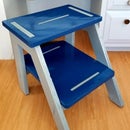Introduction: Waterjet Industrial Clock
The goal of this project was to make a very industrial-looking multi-tiered clock. I had some scrap metal, and a waterjet at the time, so I decided to send it.
I used the waterjet in my school's makerspace, the Invention Studio at Georgia Tech.
Supplies
Materials:
- 12”x12” sheet of 1/8-inch aluminum
- 10-24 screws
- 10-24 lock nuts
- ¼ inch ID vinyl tubing
- Clock Mechanism + batteries (you will need one that has the hanging hook at the back)
Tools
- Waterjet
- Drill Press
- Belt sander
- Deburring tool
- CAD software: Fusion360
- DXF editing software: inkscape
- Scissors
Step 1: Ideation
Since the geometry of getting the holes to line up and making sure the overlapping portions will fit into a circle, I decided to do all the math of the circles on paper first. Essentially, they are a bunch of concentric circles that overlap at different portions. This was the most painful step, but it made the CAD process a lot quicker and easier.
Step 2: CAD and DXF Generation
I used Fusion360 to model all the pieces in one file. This made it easy to visualize where everything overlapped and where I needed to make holes. I made sure the central hole was large enough to fit the clock mechanism through. The other holes are about 0.2 inches to fit the 10-24 screws through. I based my sketch off of 3 circles then made construction lines at all the angles at which I had cuts. In each sketch of each piece, I simply outlined the parts of the lines that I wanted as my final shape. I then saved all the shapes as DXF files for easy cutting.
Step 3: DXF Modification in Inkscape
Text is a bit difficult in Fusion360 for waterjet purposes (the characters are not made with one path). Basically, if I tried to cut out the number ‘9’ out with a normal font, the middle hole in the 9 will also fall out, but I need it there. So, what I need is a stencil-style font, so the numbers’ inner details do not fall out. I imported the DXFs into inkscape to add text. I found a stencil-style font in inkscape’s font library to add the numbers to the design for each piece. I added the 3, 6, 9, and 12 times to the clock. Gotta keep it classy.
Attachments
Step 4: Waterjetting
A brief intro to the awesome technology that is waterjetting: The basic principle is that water is pressurized to 40k-60k PSI, mixed with a high-hardness abrasive, and blasted at metal in a thin stream to make precise cuts. Because the cut is happening under water, the material does not heat up and deform or weaken due to heat. Because there is no laser, or dry grinding, waterjetting is safe on most materials including polycarbonate (not laser cut safe) and carbon fiber (not Dremel-safe).
Now that we have the DXF, cutting out the clock from the raw sheet metal is the fun part. I uploaded the DXF to the OMAX Maxiem waterjet using the proprietary program OMAX Layout. I used Layout to convert the DXF into a waterjet path file. This path file has all the cut lines from my DXF, but also includes traverses (where the waterjet head moves to a new location, but is not spraying water) and tabs (parts of the product that are left connected to the big stock so that it does not sink to the bottom of the waterjet machine). The path file is then loaded into OMAX Make, the proprietary waterjet control program. The material is clamped in, the X, Y, and Z machine homes are set, and the waterjet is started.
The cut took about 30 min. I have included a gif I found on google of what waterjetting looks like (it is not my project)
When done, use a file, sander and deburring tool to remove sharp edges on the metal from the cut.
Step 5: Assembly
1. Cut the vinyl tubing into _ 1.25 inch sections (change based on length of screw)
2. Insert the screws and vinyl tubing in the order shown in the above images and tighten a screw on the end.
3. Do this for all the holes in the design
4. Insert the clock mechanism through the middle hole and tighten the hands onto it. (make sure clock mechanism fits through thickness of metal)
Step 6: Final Product
After you insert the clock mechanism through the central hole, the clock can be hung up with either command strips or with a single nail holding it up by the mechanism.

Participated in the
Clocks Contest












